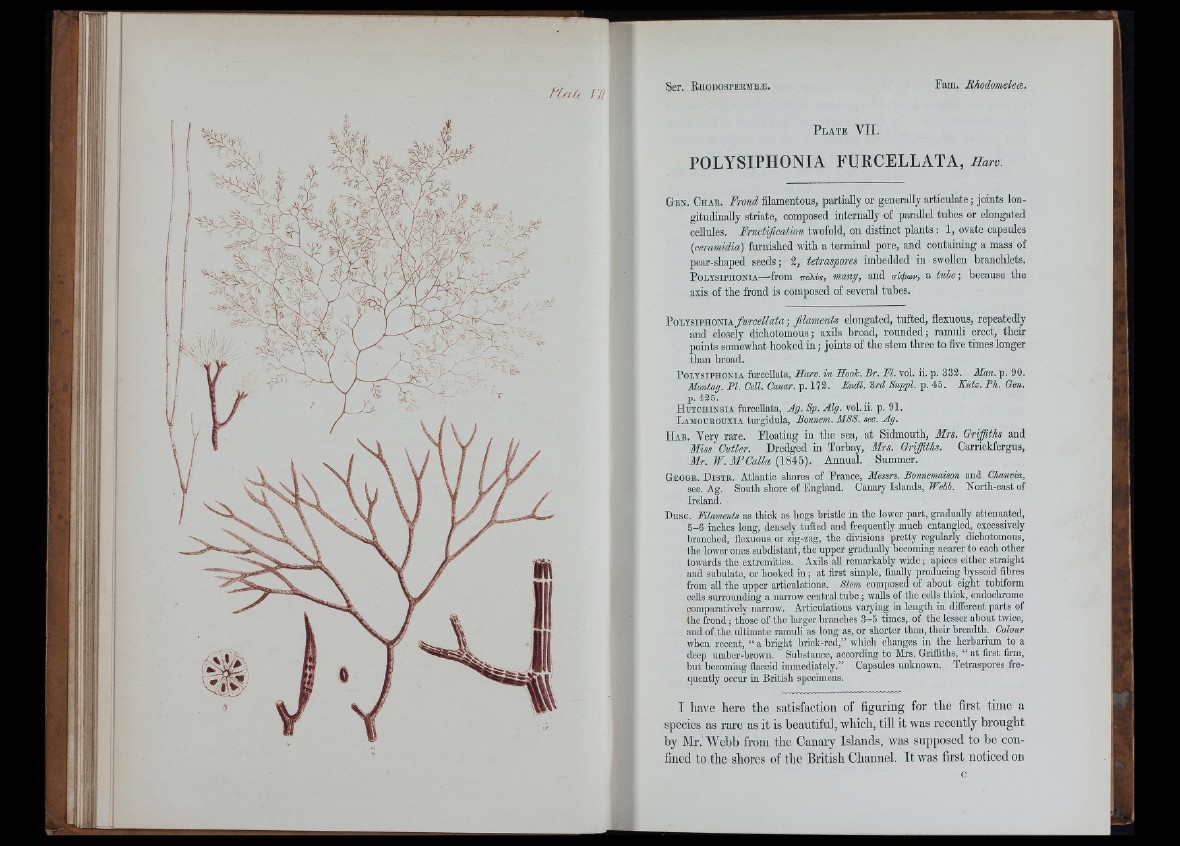
FlnC I 'U \
P l a t e VII.
POLYSIPHONIA FURCELLATA, Haw.
Gen. Char. Frond filamentous, partiaUy or generally articu la te ; joints longitudinally
striate, composed internally of parallel tubes or elongated
cellules. Fructification twofold, on distinct plants ; 1, ovate capsules
[ceramidia) furnished with a terminal pore, and containing a mass of
pear-shaped seeds; 2, tetraspores imbedded in swollen branchlets.
PoLYSiPHONiA— from TToXtf, many, and aitjxav, a tube; because the
axis of the frond is composed of several tubes.
ToiYSi'euo'SiA fiurcellata; filaments elongated, tufted, flexuous, repeatedly
and closely dichotomous; axils broad, rounded; ramuli erect, their
points somewhat hooked i n ; joints of the stem tluee to five times longer
than broad.
POLYSIPHONIA furcellata, Harv. in Hook. Br. FI. vol. 11. p. 332. Man. p. 90.
Montag. FI. Cell. Canar. p. 1 7 2 . F td l. 3rd Suppl. p. 45. Kiitz. Ph. Gen.
p. 425.
H u t c h in s ia fu rc e lla ta , Ag. Sp. Alg. vol. ii. p. 9 1 .
L am o u ro u x ia tui-gidula, Bonnem. MSS. see. Ag.
Hab . Very rare. Floating in the sea, at Sidmouth, Mrs. Griffiths and
Miss Cutler. Dredged in Torbay, Mrs. Griffiths. Carrickfergus,
Mr. W .M C a lla IM’Mo). Annual. Summer.
G e o g r . D i s t r . Atlantic shores of France, Messrs. Bonnemaison and Chauvin,
sec. Ag. South shore of England. Canary Islands, Wehi. North-east of
Ireland.
D e s c . Filamxnts as thick as hogs bristle in the lower part, gradually attenuated,
5-6 inches long, densely tufted and frequently much entangled, excessively
branched, flexuous or zig-zag, the divisions pretty regularly dichotomous,
the lower ones subdistant, the upper gradually becoming nearer to each other
towards the extremities. Axils all remarkably wide; apices either straight
and subulate, or hooked i n ; at fu'st simple, finally producing byssoid fibres
from aU the upper articulations. Stem composed of about eight tubiform
cells suiTounding a narrow central tu b e ; walls of the cells thick, endochrome
comparativelv narrow. Articulations varying in length in difterent parts of
the frond; those of the larger branches 3-5 times, of the lesser about twice,
and of the ultimate ramuli as long as, or shorter than, theh breadth. Colour
when recent, “ a bright brick-red,” which changes in the herbarium to a
deep umber-brown. Substance, according to Mi’s. Griffitbs, “ at first fii'm,
but becoming flaccid immediately.” Capsules unknown. Tetraspores frequently
occur in British specimens.
I have here the satisfaction of figuring for the first time a
species as rare as it is beautiful, which, till it was recently brought
by Mr. Webb from tlie Canary Islands, was supposed to be confined
to the shores of the British Channel. It was first noticed on
c